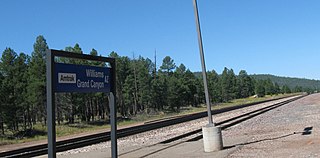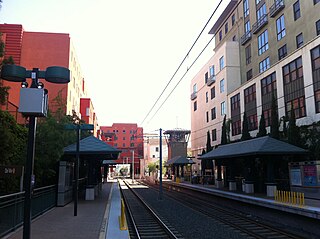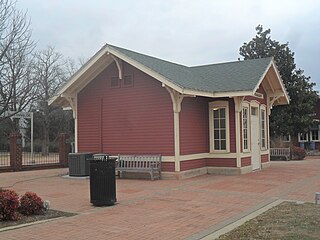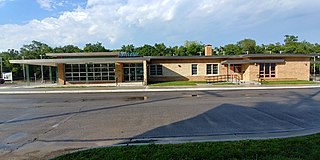
Pauls Valley is a city in and the county seat of Garvin County, Oklahoma, United States. The population was 5,992 at the 2020 census, a decline of 3.2 percent from the figure of 6,187 in 2010. It was settled by and named for Smith Paul, a North Carolina native who married a Chickasaw woman and became a citizen of the Chickasaw Nation before the Civil War. The town economy is largely based on agriculture and oil production.

Purcell is a city in and the county seat of McClain County, Oklahoma, United States. As of the 2020 census, the city population was 6,651, a 13% increase from 2010.

The Heartland Flyer is a daily passenger train that follows a 206-mile (332 km) route between Oklahoma City, Oklahoma, and Fort Worth, Texas. It is operated by Amtrak and jointly funded by the states of Oklahoma and Texas.
Oklahoma City is near the geographic center of the United States and is an integral point on the U.S. Interstate Network. The city is served by numerous roads and highways, toll roads, three major airports, a train station, a bus station, and a transit system.

The Lone Star was an Amtrak passenger train that ran between Chicago and Houston, or Dallas via Kansas City, Wichita, Oklahoma City, and Fort Worth. The train was renamed from the Texas Chief, which the Atchison, Topeka and Santa Fe Railway had introduced in 1948. Amtrak discontinued the Lone Star in 1979.

Santa Fe Depot, also known as the Santa Fe Transit Hub, is an Amtrak station located in downtown Oklahoma City, Oklahoma. It is the northern terminus of the Heartland Flyer, a daily train to Fort Worth, Texas.

Norman is an Amtrak station in Norman, Oklahoma. The station is serviced by the daily Heartland Flyer, which travels from Fort Worth, Texas to Oklahoma City, Oklahoma. The station building was added to the National Register of Historic Places in 1991 as the Santa Fe Depot.

Williams Junction station was an Amtrak train station on the Southwest Chief route, located three miles (4.8 km) southeast of Williams, Arizona in the Kaibab National Forest. The station primarily served passengers travelling to the Grand Canyon via the Grand Canyon Railway.

Ardmore is an Amtrak train station in Ardmore, Oklahoma. The station is serviced by the daily Heartland Flyer, which travels from Oklahoma City, Oklahoma to Fort Worth, Texas.

The San Bernardino Santa Fe Depot is a Mission Revival Style passenger rail terminal in San Bernardino, California, United States. It has been the primary station for the city, serving Amtrak today, and the Santa Fe and Union Pacific Railroads in the past. Until the mid-20th century, the Southern Pacific Railroad had a station 3/4 of a mile away. It currently serves one Amtrak and two Metrolink lines. The depot is a historical landmark listed on the National Register of Historic Places as Atchison, Topeka and Santa Fe Railway Passenger and Freight Depot.

Del Mar station is an at-grade light rail station on the A Line of the Los Angeles Metro Rail system. It is located between Arroyo Seco Parkway and Raymond Avenue at Del Mar Boulevard, after which the station is named, in Pasadena, California. The station is located on the site of the historic Pasadena Santa Fe Depot and the station building, built in 1935, still stands on the property.

Gainesville, officially the Gainesville Santa Fe Depot, is an Amtrak train station in Gainesville, Texas. The station is serviced by Amtrak's Heartland Flyer route, which travels from Fort Worth, Texas to Oklahoma City, Oklahoma.

Pauls Valley is an Amtrak station in Pauls Valley, Oklahoma. The station is serviced by the daily Heartland Flyer, which travels from Oklahoma City, Oklahoma to Fort Worth, Texas.

Lawrence station is a train station in Lawrence, Kansas, United States, served by Amtrak's Southwest Chief train. Built in 1956 to replace an older station, it was added to the National Register of Historic Places in 2018 as Santa Fe Depot.

Downtown Oklahoma City is located at the geographic center of the Oklahoma City metropolitan area and contains the principal, central business district of the region. Downtown has over 80,000 workers and over 13,310,000 sq ft (1,237,000 m2) of leasable office space to-date. Downtown Oklahoma City is the legal, financial, economic, nightlife, and entertainment center of the region.

Guthrie station is a former railway station in Guthrie, Oklahoma. Built in 1903, it saw passenger service until 1979 and is now a restaurant. The building is a contributing resource of the Guthrie Historic District.

Galesburg Santa Fe Station was a railway station in the west central Illinois town of Galesburg. The station was along the Atchison, Topeka and Santa Fe Railway's main line and served trains such as the Super Chief and El Captain. After Amtrak took over intercity rail in the United States, it was served by trains such as the Lone Star (1971–1979) and the Southwest Chief (1971–1996).
The Eastern Flyer was a proposed medium distance inter-city train traveling between Oklahoma City in central Oklahoma and Tulsa in north-eastern Oklahoma. It was originally planned to be a private operation by the Iowa Pacific Railroad, and its services were to have included a dome car, coaches and full meal service. This would have been the first regular passenger service to Tulsa since the Santa Fe discontinued service in 1971.

Union Station is a former railway station in Wichita, Kansas. Since the end of passenger rail service to the city in 1979, it has been repurposed as commercial office space.

Chillicothe was an Amtrak stop in Chillicothe, Illinois; a suburb of Peoria. The station was a stop on the Southwest Chief between Chicago Union Station and Los Angeles Union Station before the opening of the Cameron Connector led to the train being rerouted between Galesburg and Chicago via the BNSF Railway's Mendota Subdivision in 1996.



















